- 1Department of Computer Science, Electrical and Space Engineering, Luleå University of Technology, Luleå, Sweden
- 2Riphah School of Computing and Innovation, Riphah International University, Lahore, Pakistan
- 3Department of Business, Robert H. Smith School of Business, College Park, MD, United States
Introduction: Secondary students often struggle to visualize complex biological structures, leading to low engagement and shallow understanding. These challenges are greater in resource-limited classrooms lacking laboratory equipment or modern teaching aids. To address this, we developed ScienceAR, a curriculum-aligned AR application that transforms textbook diagrams into interactive 3D models. This study evaluates its effectiveness in secondary school biology in Lahore, Pakistan.
Methods: A quasi-experimental design was used with 60 ninth-grade students randomly assigned to an experimental group (n = 30) receiving AR-enhanced instruction or a control group (n = 30) receiving traditional instruction. The seven-day intervention covered challenging biology topics such as human anatomy. Data included pre- and post-tests, student surveys, teacher observations, and student feedback. Post-test scores were analyzed using t-tests and effect size.
Results: The experimental group significantly outperformed the control group (81.0% vs. 76.1%, t(58) = 2.36, p = 0.022, Cohen's d = 0.61). Surveys showed higher ratings for enjoyment, motivation, confidence, and clarity, all above 4.0. Teachers reported greater attentiveness, questioning, and participation in AR lessons.
Discussion: AR improved test performance, engagement, and attitudes toward biology. ScienceAR demonstrates potential as a low-cost, scalable instructional tool for underserved classrooms. Limitations include the short intervention and single-site design. Future research should explore long-term impacts, cross-subject applications, and teacher training for broader implementation.
1 Introduction
Secondary biology education in Pakistan faces persistent challenges of low engagement and conceptual understanding, particularly in underserved regions where teacher training and instructional resources are limited (Ghulamani and Zareen, 2018; Ramzan and Rafiq, 2025). Despite government initiatives to improve literacy and expand access (Pakistan Bureau of Statistics, 2020; Amir et al., 2020), classrooms in low-resource areas often rely on traditional teaching methods that provide limited opportunities for visualization, interaction, and problem-based learning. These constraints affect students' ability to grasp complex biological concepts such as human anatomy, cell biology, and genetics. Augmented Reality (AR) has emerged as a promising tool for enhancing science education by combining real and virtual elements to create interactive learning experiences (Altinpulluk, 2019; Fidan and Tuncel, 2019). Research highlights AR's capacity to foster motivation, learning achievement, and positive emotions (Garzón et al., 2019; Gómez-Ríos et al., 2025; Iftene and Trandabăţ, 2018). Visualization of abstract structures through 3D models makes concepts more concrete and accessible (Videnovik et al., 2020; Schmidthaler et al., 2023). In biology, AR applications have been shown to support anatomy and physiology learning by allowing students to manipulate digital replicas of organs and systems (Khalid et al., 2019; Maulion and Prudente, 2025). Such affordances are particularly valuable in classrooms with limited laboratory facilities or teaching aids. Despite this potential, much of the existing AR-in-education research has been conducted in high-resource contexts (Arici et al., 2019; Elharbaoui et al., 2025). Few studies examine AR's role in low-literacy, resource-constrained classrooms, where technological interventions must be both low-cost and scalable. Addressing this gap, the present study introduces ScienceAR, a smartphone-based application aligned with the ninth-grade biology curriculum in Punjab, Pakistan. ScienceAR converts textbook illustrations into interactive 3D models, allowing students to explore structures such as the human heart and cell organelles in real time.
1.1 Theoretical framework
The design of ScienceAR is grounded in four complementary perspectives. Constructivism posits that learners build understanding through active manipulation of information; AR operationalizes this by enabling students to rotate, zoom, and inspect biological structures (Akçayir and Akçayir, 2017). Cognitive Load Theory suggests that learning improves when extraneous load is minimized; AR reduces split attention by co-locating text and diagrams, thus supporting germane processing (Gómez-Ríos et al., 2025). Cognitive Theory of Multimedia Learning emphasizes dual-channel processing and contiguity; AR integrates words, graphics, and spatial cues, strengthening the integration of verbal and visual codes (Garzón et al., 2019). Finally, Self-Determination Theory indicates that fostering competence and autonomy enhances motivation; AR promotes both through interactivity and learner control (Amores-Valencia et al., 2023). Drawing on these frameworks, we anticipated that AR-supported instruction would (i) improve post-test performance relative to traditional methods, (ii) enhance engagement and motivation, and (iii) be perceived by teachers and students as clearer and more enjoyable.
1.2 Focused literature review
1.2.1 Learning outcomes in science/biology
Prior studies report small to moderate gains from AR integration in science learning, especially for topics requiring spatial reasoning (Fidan and Tuncel, 2019; Maulion and Prudente, 2025). In biology classrooms, AR-based anatomy tools have improved both comprehension and retention compared to textbook-only instruction (Khalid et al., 2019). AR has been shown to increase enjoyment, confidence, and sustained attention (Gómez-Ríos et al., 2025; Amores-Valencia et al., 2023). Meta-analyses note consistent motivational benefits, often linked to interactivity and immersion (Garzón et al., 2019). Studies highlight barriers such as teacher readiness, device access, and limited lesson time (Schmidthaler et al., 2023; Arici et al., 2019). In resource-limited schools, scalable design requires offline operation, simple interfaces, and alignment with local curricula (Ghulamani and Zareen, 2018). This research evaluates the effectiveness of ScienceAR in a resource-constrained public school in Lahore. Using a mixed-methods design with pre/post testing and teacher/student feedback, we examine its impact on learning outcomes, engagement, and motivation, while also considering teacher readiness and barriers to scaling.
2 Materials and methods
This study uses a mixed approach divided into two sections. The initial focus is on developing an augmented reality (AR) application, which includes the technical and design aspects of the “ScienceAR” Application. Following that, the study moves on to the second phase, where we used qualitative and quantitative methodologies for better analysis and presentation of results. In recent years, numerous studies have shown an increasing propensity to use quantitative and mixed methodologies (Almeida, 2018). The mixed-methods design combines qualitative insights with quantitative measures, offering a more comprehensive evaluation of AR's classroom impact than either method alone (Kurniawan and Witjaksono, 2018). Initially, collaboration with students and teachers was undertaken to identify essential concepts and topics that could benefit from AR-based visualization. This initial step marked the beginning of an educational journey with transformative potential. Learning objectives for AR materials were clearly defined and aligned with the current curriculum. Blender software was used to create detailed 3d models. Its strong capabilities and user-friendly interface made creating detailed and realistic renderings for the models easier. Subsequently, efforts were made to develop visual 3d models aimed at conveying complex ideas, structures, and phenomena relevant to the identified topics. These models were meticulously designed to incorporate interactive elements, facilitating extensive exploration and manipulation, enhancing student engagement, and fostering curiosity. A book picture and a 3d representation of a heart model are presented in Figure 1.
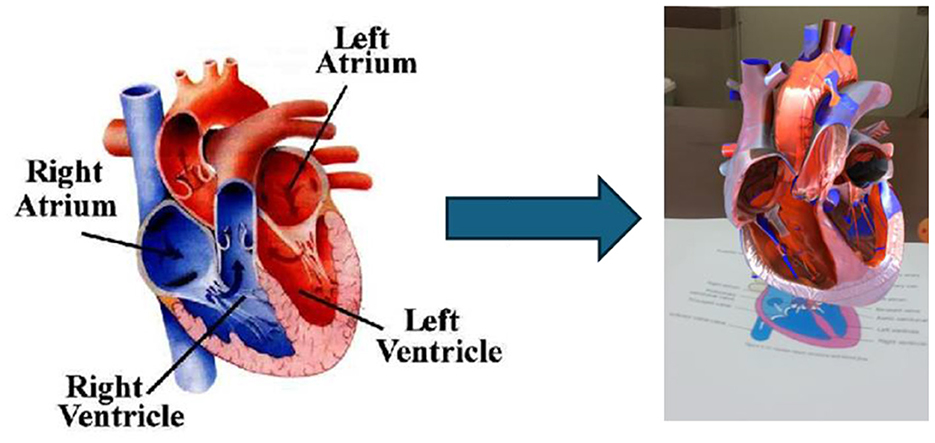
Figure 1. Transformation of textbook content into an interactive AR model. A two-dimensional diagram of the human heart from the ninth-grade biology textbook (left) was digitized and converted into a three-dimensional AR model (right). The AR version allows learners to rotate, zoom, and interact with the anatomical structure, enhancing visualization of components such as the atria and ventricles and supporting deeper understanding of circulatory system functions.
Unity software was used to create AR applications. Unity AR Foundation architecture allows for seamless integration of digital content into the real world. Specifically, Blender was used to construct detailed 3D anatomical and cellular models, which were then optimized for rendering performance. Unity's AR Foundation was used to overlay these models in real classroom environments. The link between “3D content creation” and “AR content creation” (Figure 2) is established through model export–import processes, where cleaned 3D models are converted into AR-ready assets. Figure 2 shows the AR application process (Jamali et al., 2015).

Figure 2. Workflow of ScienceAR development. Textbook diagrams were first digitized and processed during the 3D content creation stage (image capturing, photo processing, and model cleanup). The refined models were then integrated into the AR environment (marker selection, model import, and adjustment). The final output was deployed on mobile devices, enabling students to interact with AR-enhanced textbook content in the classroom.
In the latter part of the study, a mixed strategy was chosen, which included quantitative and qualitative methods to present a comprehensive picture of the problem, including measurable learning outcomes, teachers‘ in-depth knowledge, and students' experiences and perspectives. Quantitative and qualitative findings were integrated through triangulation. Post-test score differences were interpreted alongside qualitative themes (e.g., curiosity, confidence, attentiveness) derived from focus group interviews and teacher observations. This integration provided a more comprehensive interpretation of AR's impact on learning and engagement. A time trial method was used in the quantitative phase to examine the direct impact of AR-enhanced 3d visual models on learning outcomes. Students in the biology group were randomly assigned to either an experimental group that used AR to facilitate learning or a control group that used conventional teaching methods. Both groups receive a post-test to track progress in learning outcomes. Quantitative data, including review scores, demographic information, and engagement metrics, are collected for AR events. Statistical methods such as paired t-tests are used to determine the statistical significance of changes in learning outcomes between experimental and control groups. The qualitative part of the study explores the experiences, perspectives, and barriers of teachers and students with AR-enhanced 3d visual models. Semi-structured interviews will be conducted with teachers who have integrated AR technology into their teaching, and focus group discussions with students who have participated in AR-enhanced learning. The overall experimental design, including group allocation, intervention procedures, and evaluation sequence, is summarized in Figure 3.
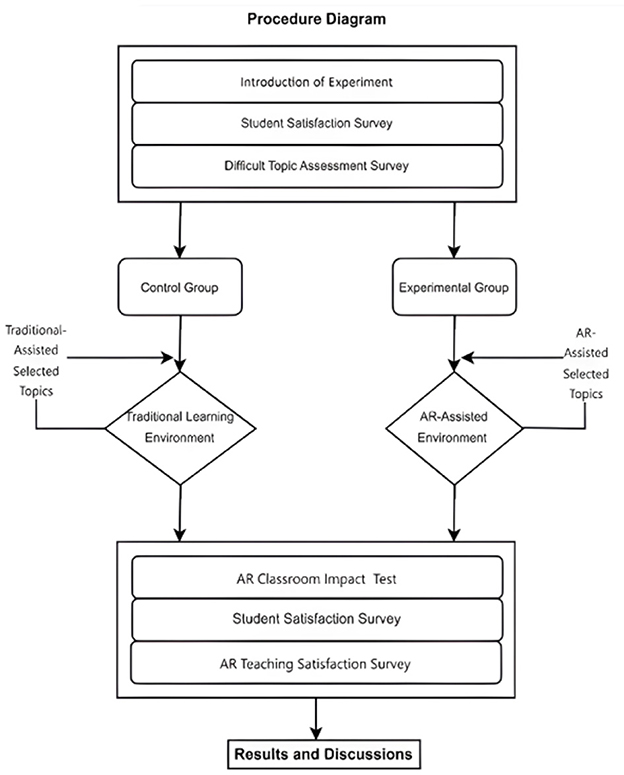
Figure 3. Experimental procedure for the ScienceAR study. Students were introduced to the experiment and completed initial surveys, including a satisfaction survey and a difficult topic assessment survey. They were then divided into a control group (traditional learning environment) and an experimental group (AR-assisted environment). Each group studied the same biology topics using their assigned method. After the intervention, both groups completed post-tests and surveys measuring classroom impact, student satisfaction, and teacher satisfaction. The results were subsequently analyzed and discussed.
3 Results
In this section, we demonstrate the real implementation of the ScienceAR application in the classroom and the results obtained from its deployment. We describe the development process and integration approaches used to introduce AR technology into the classroom environment smoothly. Following that, we discuss the study's findings, thoroughly analyzing qualitative and quantitative data through user comments, observational insights, and statistical findings. Furthermore, we highlight the impact of the AR application on classroom dynamics and educational outcomes, shedding light on its efficacy in improving the learning experience.
3.1 Student enjoyment and satisfaction survey
We conducted a classroom survey to assess students' enjoyment and satisfaction with existing teaching methods. The survey questionnaire specifically assessed the aspects: participation in class discussions, student satisfaction with the teaching method, degree of student confidence, degree of student learning in biology is fun and exciting, and students contact students for clarification before answering. The survey results informed our decision to introduce AR technology as a new teaching approach. So, we decided to go with AR Technology. The survey results are shown in Figure 4.
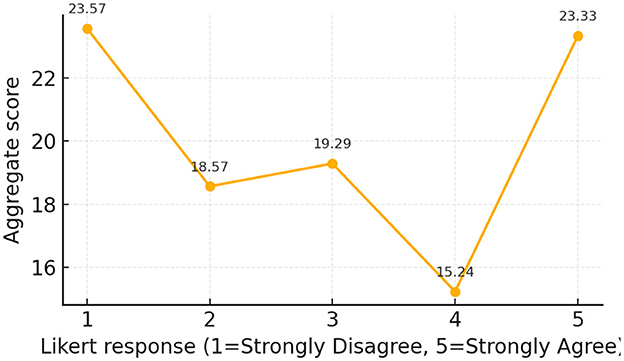
Figure 4. Student survey responses on engagement and experience with conventional biology teaching methods prior to the AR intervention. Aggregate scores are shown against Likert response categories (1 = Strongly Disagree to 5 = Strongly Agree). Results indicate relatively low enjoyment, satisfaction, and engagement with traditional teaching approaches, which motivated the shift to AR-based lessons.
Continuing the first survey, we conducted a second one in the classroom to extract students' perceptions of the difficulty levels of various course topics. This survey aimed to go beyond traditional exams by immersing ourselves in the different experiences and hurdles students encounter in their academic journey. The questionnaire was carefully created with diverse questions designed to get real answers to the most challenging topics. The survey consists of the most difficult issues of the biology book, such as botany, zoology, microbiology, biochemistry, and human anatomy. This survey aimed to explore the complexity of students‘ experiences and perspectives on these different but related topics.
The survey revealed clear trends regarding which biology topics students found most challenging. Human Anatomy was reported as the most difficult (55%), followed by Genetics (15%), Evolution (15%), Cell Biology (8%), and other topics (7%). These results highlight the areas where students struggle the most and guide the selection of content for AR enhancement. By involving students directly in identifying complex topics, the survey ensured that the intervention was both relevant and responsive to their learning needs. The results are shown in Figure 5.
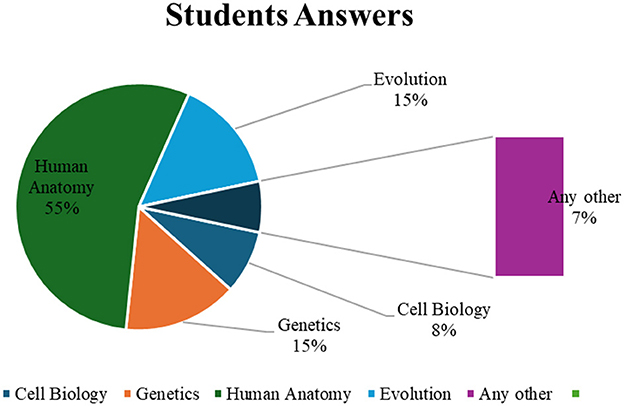
Figure 5. Students' responses on the most difficult biology topics. Survey results (n = 60) indicated that Human Anatomy was the most frequently reported area of difficulty (55%), followed by Genetics (15%), Evolution (15%), Cell Biology (8%), and other topics (7%). These findings were used to guide the selection of content for AR-based enhancement.
3.2 AR app development based on 3D models
Based on the survey results, we developed the ScienceAR Android application using Unity 3D and the Vuforia framework. The app integrated 3D models aligned with students' identified learning difficulties, enabling seamless navigation and real-time interaction with biological structures. The user interface was designed to be simple, accessible, and engaging for secondary school students. This immersive application allowed learners to visualize and manipulate complex biological content directly within their classroom lessons. A real-time classroom implementation is shown in Figure 6.
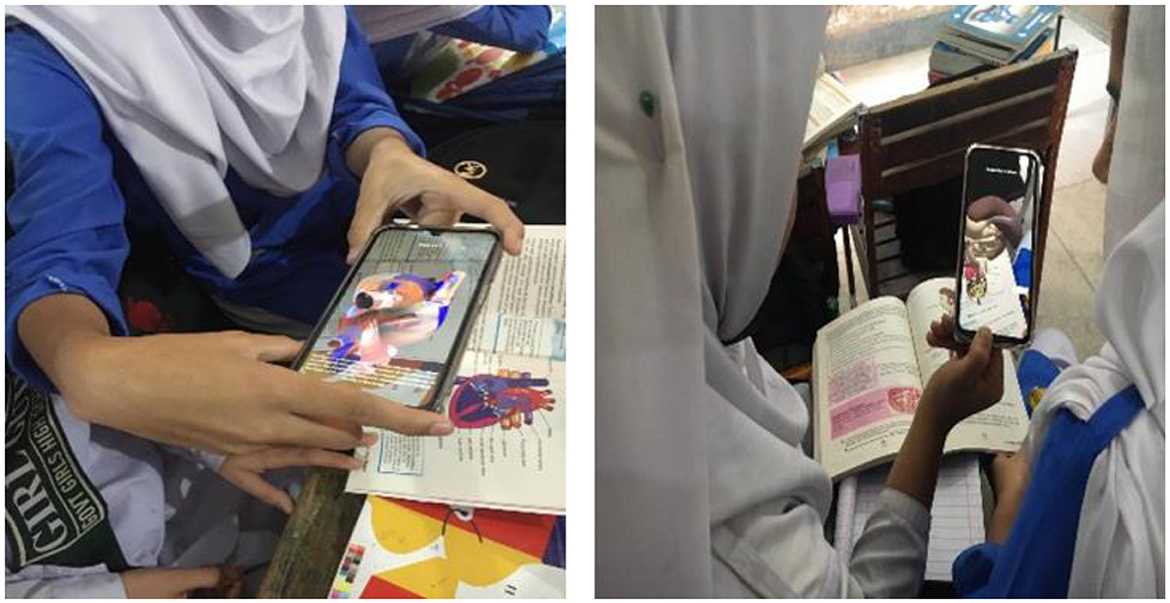
Figure 6. Classroom implementation of ScienceAR. Students using smartphones and tablets to interact with AR models during biology lessons. The AR application allowed learners to overlay three-dimensional representations of anatomical structures directly onto textbook pages, enabling hands-on exploration and improved engagement in a real classroom setting.
3.3 Classroom experiment
In the 9th-grade Biology course, students were divided into two groups and instructed to participate individually. Group B received lectures on selected topics through traditional methods, while the other group experienced the duplicate content delivered via Augmented Reality (AR) technology. We went to Lahore, the capital city of the province of Punjab, to experiment at City District Girls High School, Factory Area, Shahdra, Lahore, with the permission of both parents and the school administration. The school comprised seven sections for the students of the 9th class, designated as A, B, C, D, E, F, and G. A total of 421 students were enrolled across these sections, with an average of 60 students per section. To experiment, 60 students were randomly selected from different sections, forming two groups: a controlled group and an experimental group, each consisting of 30 students. Each student was assigned a unique identifier number as a primary key to facilitate tracking and record-keeping. After the first two surveys, the authors collaborated with classroom teachers to create a comprehensive experiment to assess the impact of incorporating augmented reality (AR) into their classrooms. The pre- and post-tests were 20-item paper-based assessments including multiple-choice, short-answer, and diagram-labeling questions covering the biology topics taught in the intervention. Example items included “Label the main chambers of the human heart” and “Which organelle produces cellular energy?” Surveys used 5-point Likert scales to measure engagement, confidence, enjoyment, and motivation. The complete pre- and post-surveys, topic difficulty questionnaire, and full 29-item biology test are provided as Supplementary material (S1–S4). The test was specifically constructed to measure several aspects of using AR technology, e.g., students' grasp of complex concepts and problem-solving skills. The Author collaborated with the classroom in charge to ensure a seamless alignment with the curriculum content, designed to meet the learning outcomes and objectives, and paired with the AR-enhanced approach to learning. The comprehensive nature of the test allows for a detailed analysis of AR's effectiveness in increasing student learning and academic achievement in specific areas. During the test, the classroom environment is shown in Figure 7.

Figure 7. Experimental group classroom during the AR-based intervention. Students in the experimental group at City District Girls High School, Lahore, participating in a ninth-grade biology lesson. The session combined textbook content with AR-enhanced activities, allowing learners to engage more actively with complex biological concepts in a typical public-school setting.
3.4 Assessment test results
The test results showed that the students in the experimental group performed better. The students in the control group obtained an average of 76.091% and those in the experimental group 81.034%. This difference represents a 5% increase in scores for the experimental group compared to the control group. The improvements observed in the test groups and the results show the benefit of the reality technology (AR) for the students. Class test findings support the effectiveness of incorporating augmented reality (AR) into classroom environments, indicating its ability to impact learning outcomes in the areas studied positively. Test results are graphically shown in Figures 8, 9.
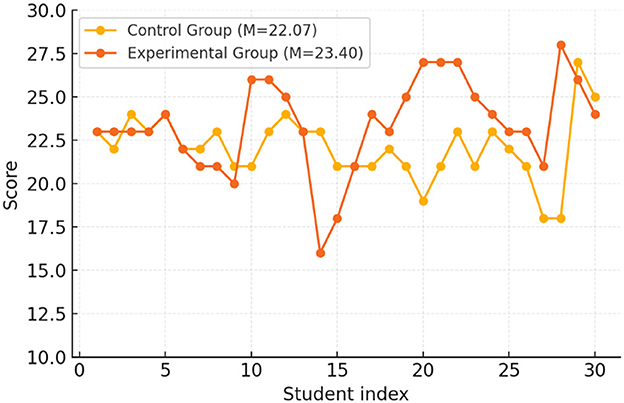
Figure 8. Individual post-test scores of students in the control group (M = 22.07, SD = 1.89) and experimental group (M = 23.50, SD = 2.74). Each point represents one student (n = 30 per group). Horizontal reference lines show group means. The experimental group consistently achieved higher scores than the control group, t(58) = 2.36, p = 0.022, Cohen's d = 0.61, indicating a moderate effect size.
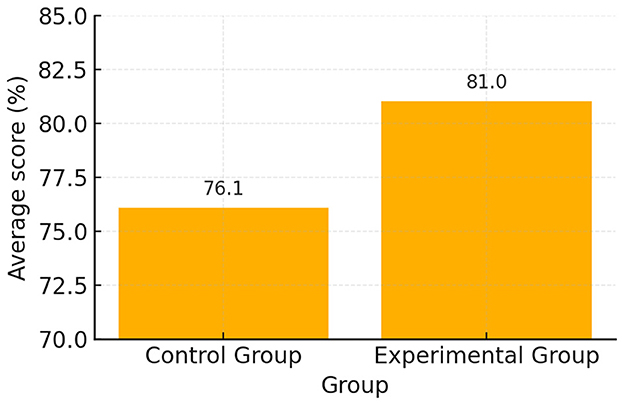
Figure 9. Average post-test scores (%) of the control and experimental groups (n = 30 each). Bars represent mean performance, with the control group scoring 76.1% and the experimental group 81.0%. The 5% improvement in the experimental group was statistically significant, t(58) = 2.36, p = 0.022, Cohen's d = 0.61, indicating a moderate effect size favoring AR-based instruction.
Figure 8 shows that the experimental group achieved higher average post-test scores than the control group (81.0% vs. 76.1%). This represents a meaningful 5% improvement, confirming the effectiveness of AR-based lessons in enhancing academic performance. Figure 9 illustrates individual student scores for both groups. The distribution shows that while some variability exists, the experimental group consistently achieved higher marks, further supporting the positive effect of the AR intervention.
3.5 Statistical analysis
To assess the effectiveness of the ScienceAR application in enhancing student learning outcomes, an independent-samples t-test was conducted comparing the post-intervention scores of the experimental group (n = 30), who used the AR app, and the control group (n = 30), who received traditional instruction. Descriptive statistics (means, SDs, minimum and maximum values) for both groups are shown in Table 1. The analysis revealed that the experimental group scored significantly higher (M = 23.50, SD = 2.74) than the control group (M = 22.07, SD = 1.89), t(58) = 2.36, p = 0.022. The effect size was moderate (Cohen's d = 0.61), with a 95% confidence interval for the mean difference ranging from 0.22 to 2.65. These results provide clear evidence that using the ScienceAR application led to a meaningful improvement in academic performance, supporting the effectiveness of augmented reality tools in enhancing engagement and conceptual understanding in secondary biology. As summarized in Table 1, AR-supported lessons produced higher post-test scores than traditional instruction.

Table 1. Post-test performance and statistical comparison of control and experimental groups: Control vs. Experimental Group Score Differences and Deviation Calculations.
3.6 Post-experiment assessment
After successfully implementing augmented reality (AR) technology in the classroom, we conducted a post-test evaluation based on the enjoyment questionnaire and a satisfaction survey 1 to analyse its impact on the learning environment. This post-test evaluation, which included a structured and comprehensive questionnaire, aimed to provide a helpful definition of the quality aspects of an AR-enhanced learning environment. Data collected from sample responses will improve training methods and optimize the integration of AR technology to improve overall training. Survey results are shown in Figure 10. Results indicates that students rated AR lessons highly across all categories. Mean Likert scores exceeded 4.0 for enjoyment, comprehension, and motivation, demonstrating that AR was perceived as both engaging and effective.
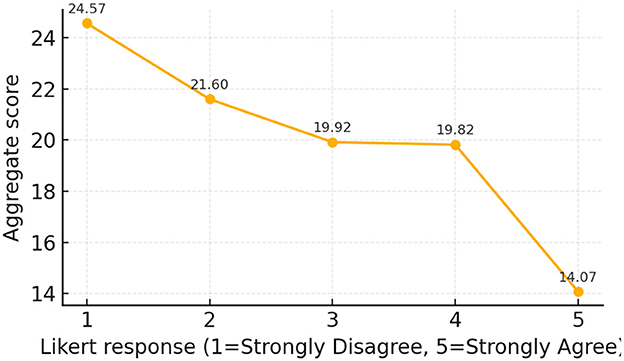
Figure 10. Post-intervention survey results on satisfaction and learning improvement with AR lessons. Aggregate scores are plotted against Likert response options (1 = Strongly Disagree to 5 = Strongly Agree). Higher values on the Y-axis reflect stronger agreement across domains such as enjoyment, comprehension, and motivation. Mean Likert ratings exceeded 4.0 (Agree) across categories, indicating that students perceived AR-based lessons as highly engaging and effective.
3.7 Pre and post-implementation comparison
We compared pre- and post-intervention survey scores for engagement, confidence, enjoyment, and motivation. These indicators capture how actively students participated in lessons and how their perceptions of learning changed after the AR intervention. Results are shown in Figure 11. Results demonstrates consistent improvements across all survey domains following AR implementation. Increases were most notable in student confidence and classroom engagement, highlighting the broader benefits of AR beyond academic test scores.
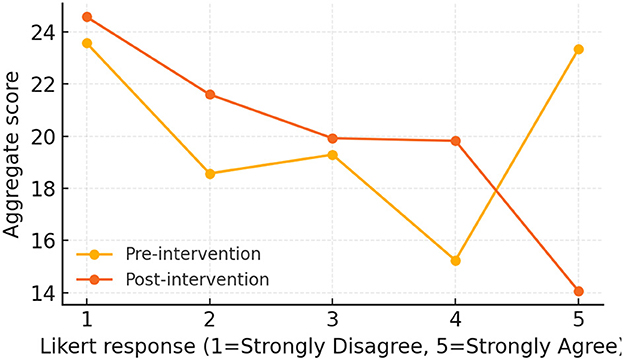
Figure 11. Pre- and post-intervention survey comparison across Likert response categories (1 = Strongly Disagree to 5 = Strongly Agree). The post-intervention responses show consistently higher aggregate scores than pre-intervention across domains such as engagement, confidence, enjoyment, and motivation. Improvements were most notable in confidence and classroom engagement, highlighting the broader benefits of AR beyond academic test scores.
4 Discussion
The findings of this study highlight the strong pedagogical potential of augmented reality (AR) as an instructional tool that enhances student engagement, conceptual understanding, and overall learning outcomes in secondary science education. The development of ScienceAR addressed a gap in Pakistan's resource-constrained schools, where students often face abstract concepts without adequate visual aids and teachers have limited opportunities to adopt innovative methods. By transforming textbook illustrations into interactive three-dimensional models, ScienceAR created opportunities for experiential learning and made previously inaccessible content more tangible.
4.1 Learning outcomes and engagement
Quantitative results demonstrated that students who used ScienceAR outperformed their peers in the control group on post-test assessments. Although the difference was modest in absolute terms, it was statistically significant and reinforces earlier studies reporting that AR enhances student motivation, manages cognitive load more effectively, and strengthens conceptual comprehension (Fidan and Tuncel, 2019; Garzón et al., 2019). Survey results confirmed that learners perceived AR-based lessons as more engaging, motivating, and enjoyable than traditional instruction, which is consistent with previous findings that immersive learning environments foster more positive student attitudes (Geng and Yamada, 2023). Teacher observations provided additional insights into classroom dynamics. Instructors reported increased attentiveness, greater participation, and more frequent student questioning during AR lessons. These behavioral changes indicate that AR can transform classroom culture by encouraging active involvement rather than passive reception. From a theoretical perspective, these outcomes align closely with constructivist learning theory, which emphasizes that knowledge is most effectively acquired through active engagement and meaningful manipulation of information. AR enables learners to interact with biological systems in ways that promote deeper conceptual understanding.
4.2 Mechanisms of impact
The results also raise important questions about the underlying mechanisms driving improvements in learning outcomes. Three potential explanations should be considered: novelty, interactivity, and visualization. First, novelty effects may contribute to short-term motivation, as students are often enthusiastic when introduced to new technologies. However, novelty alone is unlikely to sustain learning gains beyond initial exposure. Second, interactivity plays a key role by giving learners agency over how they explore content. This autonomy can increase motivation and support the development of spatial reasoning. Third, visualization is critical because it transforms abstract and often invisible processes into concrete, manipulable models. The combination of interactivity and visualization appears to be the most powerful factor in facilitating understanding, since students reported that AR made complex topics clearer and easier to grasp. Future studies could investigate these mechanisms more systematically, for example by comparing AR with static 3D images or videos to isolate the effects of interactivity from novelty and visualization.
4.3 Teacher readiness, training needs, and scaling barriers
While this study focused on student outcomes, the role of teachers in implementing AR is equally important. Successful integration requires not only access to technology but also adequate teacher preparation. Teachers must be able to align AR activities with curriculum objectives, manage classroom pacing, and troubleshoot technical issues. In low-resource settings, challenges such as device scarcity, limited lesson time, and lack of professional development opportunities present additional barriers. Providing structured training that includes demonstrations, co-teaching models, and opportunities for teachers to design their own AR-enhanced lessons will be critical for sustainable adoption. Without teacher readiness, AR risks being perceived as a novelty rather than a serious pedagogical tool.
4.4 Broader impact: digital divide and accessibility
The successful deployment of ScienceAR in a resource-limited school demonstrates that AR can be feasible with modest infrastructure, such as low-cost smartphones and printed AR markers. This is an encouraging finding, yet broader issues of equity and accessibility remain. Many schools face limitations in terms of device availability, internet connectivity, and digital literacy. These factors contribute to the digital divide, where some students benefit from technological innovations while others are left behind. To address this, AR applications should be designed to function offline, be optimized for low-spec devices, and include features that support accessibility such as clear labels, high contrast visuals, and audio narration. Incorporating universal design principles can help ensure that AR is inclusive for students with diverse needs and abilities.
4.5 Limitations
Although the results of this study are encouraging, several limitations should be acknowledged. First, the intervention involved a relatively small sample of sixty students from a single school, which limits the generalizability of the findings. Future research should involve larger and more diverse populations across multiple schools and regions. Second, the duration of the intervention was limited to seven days. While measurable improvements were observed in this short period, it is not clear whether the gains would persist over time or whether novelty effects contributed to the outcomes. Longitudinal studies are needed to assess the durability of learning benefits and their impact on retention. Third, this study was restricted to biology content, particularly human anatomy. Expanding AR integration into other science subjects would provide a more comprehensive picture of its cross-disciplinary effectiveness.
4.6 Future work
Future studies should adopt more comprehensive research designs. Longitudinal investigations that include delayed post-tests could measure retention and help clarify whether AR provides lasting benefits beyond the intervention period. Comparative designs that include video-based 3D instruction or static 3D images could help isolate the unique contributions of AR interactivity. In addition, multi-site studies involving schools from diverse regions would allow for stronger generalization of results. Research should also explore differential impacts across gender, socio-economic status, and prior academic achievement, since AR may benefit some groups more than others. Finally, investigating teacher training strategies and the scalability of AR in national curricula would provide practical insights for policymakers and educators.
4.7 Implications beyond biology
Although this study focused on biology, the implications of AR extend to other STEM disciplines. In chemistry, AR could allow students to visualize molecular structures and reaction pathways in three dimensions. In physics, it could help learners explore forces, fields, and circuits through interactive simulations. In mathematics, AR can provide spatial visualizations of geometric transformations or three-dimensional graphs. These applications would build on the same theoretical foundations of constructivism, cognitive load management, and multimedia learning theory, making AR a versatile tool across the STEM curriculum.
5 Conclusions
This study explored the role of augmented reality (AR) in enhancing student engagement and academic performance in secondary-level biology education. Through the development and classroom deployment of the ScienceAR application, the research demonstrates that integrating AR into traditional teaching methods can lead to meaningful improvements in students' understanding of complex biological concepts, particularly in contexts where access to modern teaching aids is limited. The findings from the quasi-experimental design, supported by both quantitative and qualitative data, indicate that students who engaged with the ScienceAR application exhibited higher levels of interest, motivation, and subject mastery compared to those taught through conventional methods. This was evident in test performance and behavioral indicators such as increased participation, curiosity, and sustained attention during classroom sessions. The positive response from students and teachers suggests that AR is not merely a novelty but a powerful instructional tool that can transform passive learning into an active and immersive experience. One of the key contributions of this study lies in its focus on underserved educational environments. By designing a low-cost, curriculum-aligned AR application and testing it in a public-school setting, the research addresses practical barriers to technology adoption in developing regions. The results suggest that AR has potential as an equalizing force in education; however, this conclusion is limited to one school context, a modest sample size, and a short-term intervention. However, while the outcomes are promising, the study has limitations. The short intervention period and relatively small sample size suggest the need for extended studies to evaluate long-term learning gains and retention. Future research should also investigate the scalability of AR applications across different subjects and educational levels and their adaptability for diverse student populations, including those with special learning needs. In conclusion, this study provides empirical evidence that augmented reality can be a valuable pedagogical enhancement in science education. Integrating AR into formal curricula holds substantial promise for improving the quality of learning experiences, especially in resource-constrained contexts. As digital learning continues to evolve, tools like ScienceAR can play a critical role in fostering curiosity, deepening conceptual understanding, and building the digital literacy skills essential for the learners of the future.
Data availability statement
The original contributions presented in the study are included in the article/Supplementary material, further inquiries can be directed to the corresponding author.
Ethics statement
The studies involving humans were approved by Principal City District Girls High School, Factory Area, Shahdra, Lahore. The studies were conducted in accordance with the local legislation and institutional requirements. Written informed consent for participation in this study was provided by the participants‘ legal guardians/next of kin. Written informed consent was obtained from the individual(s), and minor(s)' legal guardian/next of kin, for the publication of any potentially identifiable images or data included in this article.
Author contributions
MM: Conceptualization, Data curation, Formal analysis, Funding acquisition, Investigation, Methodology, Project administration, Resources, Software, Supervision, Validation, Visualization, Writing – original draft, Writing – review & editing. MS: Conceptualization, Data curation, Formal analysis, Funding acquisition, Investigation, Methodology, Project administration, Resources, Software, Supervision, Validation, Visualization, Writing – original draft, Writing – review & editing. FZ: Conceptualization, Formal analysis, Methodology, Resources, Visualization, Writing – review & editing. MB: Investigation, Project administration, Resources, Validation, Writing – review & editing.
Funding
The author(s) declare that no financial support was received for the research and/or publication of this article.
Conflict of interest
The authors declare that the research was conducted in the absence of any commercial or financial relationships that could be construed as a potential conflict of interest.
Generative AI statement
The author(s) declare that Gen AI was used in the creation of this manuscript. The author(s) verify and take full responsibility for the use of generative AI in the preparation of this manuscript. GPT-4o was used solely to improve grammar, clarity, and formal academic language. All content, analysis, and interpretation were developed by the author(s).
Any alternative text (alt text) provided alongside figures in this article has been generated by Frontiers with the support of artificial intelligence and reasonable efforts have been made to ensure accuracy, including review by the authors wherever possible. If you identify any issues, please contact us.
Publisher's note
All claims expressed in this article are solely those of the authors and do not necessarily represent those of their affiliated organizations, or those of the publisher, the editors and the reviewers. Any product that may be evaluated in this article, or claim that may be made by its manufacturer, is not guaranteed or endorsed by the publisher.
Supplementary material
The Supplementary Material for this article can be found online at: https://www.frontiersin.org/articles/10.3389/feduc.2025.1628004/full#supplementary-material
References
Akçayir, M., and Akçayir, G. (2017). Advantages and challenges associated with augmented reality for education: A systematic review of the literature. Educ. Res. Rev. 20, 1–11. doi: 10.1016/j.edurev.2016.11.002
Almeida, F. (2018). Strategies to perform a mixed methods study. Eur. J. Educ. Stud. 5, 137–150. doi: 10.5281/zenodo.1406214
Altinpulluk, H. (2019). Determining the trends of using augmented reality in education between 2006–2016. Educ. Inf. Technol. 24, 1089–1114. doi: 10.1007/s10639-018-9793-3
Amir, S., Sharf, N., and Khan, R. A. (2020). Pakistan's education system: an analysis of education policies and drawbacks. Elec. Res. J. Soc. Sci. Hum. 2. Available online at: https://ssrn.com/abstract=3549953
Amores-Valencia, A., Burgos, D., and Branch-Bedoya, J. W. (2023). The influence of augmented reality (AR) on the motivation of high school students. Electronics 12:4715. doi: 10.3390/electronics12224715
Arici, F., Yildirim, P., Caliklar, S., and Yilmaz, R. M. (2019). Research trends in the use of augmented reality in science education: content and bibliometric map-ping analysis. Comput. Educ. 142:103647. doi: 10.1016/j.compedu.2019.103647
Elharbaoui, E., Zineddin, D., Ntebutse, J. G., and Ben-Attia, M. (2025). Augmented reality-based teaching-learning tool, and the evolution of conceptions about “human breathing”: fifth-grade basic Tunisian students' case. J. Digit. Educ. Technol. 5:ep2507. doi: 10.30935/jdet/15863
Fidan, M., and Tuncel, M. (2019). Integrating augmented reality into problem-based learning: the effects on learning achievement and attitude in physics education. Comput. Educ. 142:103635. doi: 10.1016/j.compedu.2019.103635
Garzón, J., Pavón, J., and Baldiris, S. (2019). Systematic review and meta-analysis of augmented reality in educational settings. Virtual Real. 23, 447–459. doi: 10.1007/s10055-018-0363-2
Geng, X., and Yamada, M. (2023). Using learning analytics to investigate learning processes and behavioural patterns in an augmented reality language learning environment. J. Comput. Assist. Learn. 39, 532–546. doi: 10.1111/jcal.12760
Ghulamani, S., and Zareen, S. (2018). “Educating students in remote areas using augmented reality,” in 2018 International Conference on Computing, Mathematics and Engineering Technologies (iCoMET) (Sukkur, Pakistan: IEEE), 1–6.
Gómez-Ríos, A., Paredes-Velasco, M., and Martín-Gutiérrez, J. (2025). Augmented reality for learning algorithms: evaluation of its impact on students' emotions using artificial intelligence. Appl. Sci. 15:7745. doi: 10.3390/app15147745
Iftene, A., and Trandabăţ, D. (2018). Enhancing the attractiveness of learning through augmented reality. Procedia Comput. Sci. 126, 166–175. doi: 10.1016/j.procs.2018.07.220
Jamali, S. S., Shiratuddin, M. F., and Wong, K. W. (2015). Utilising mobile-augmented reality for learning human anatomy. Procedia Soc. Behav. Sci. 197, 659–668. doi: 10.1016/j.sbspro.2015.07.059
Khalid, F., Muryam, M., Begum, T., and Khalid, A. (2019). “AREd: anatomy learning using augmented reality application,” in 2019 International Conference on Engineering and Emerging Technologies (ICEET) (Lahore, Pakistan: IEEE), 1–6.
Kurniawan, M. H., and Witjaksono, G. (2018). Human anatomy learning systems using augmented reality on mobile application. Procedia Comput. Sci. 135, 80–88. doi: 10.1016/j.procs.2018.08.152
Maulion, R. J. V., and Prudente, M. S. (2025). Augmented reality in biology education: a meta-analysis of its effects on student achievement. Ignatian Int. J. Multidiscip. Res. 3, 1736–1751. doi: 10.5281/zenodo.15343043
Pakistan Bureau of Statistics (2020). Pakistan Social and Living Standards Measurement Survey 2019–2020. Available online at: https://www.pbs.gov.pk (Accessed May 9, 2025).
Ramzan, M., and Rafiq, S. (2025). A prelude to improving school education in Punjab, Pakistan. Soc. Sci. Spectr. 4, 487–505. doi: 10.71085/sss.04.01.233
Schmidthaler, E., Andic, B., Schmollmüller, M., Sabitzer, B., and Lavicza, Z. (2023). Mobile augmented reality in biological education: perceptions of Austrian secondary school teachers. ERIES J. 16, 113–127. doi: 10.7160/eriesj.2023.160203
Keywords: augmented reality, educational technology, biology education, classroom engagement, ScienceAR
Citation: Sattar MA, Maqbool MU, Zakir F and Billah M (2025) Enhancing student engagement through augmented reality in secondary biology education. Front. Educ. 10:1628004. doi: 10.3389/feduc.2025.1628004
Received: 13 May 2025; Accepted: 09 September 2025;
Published: 26 September 2025.
Edited by:
Aslina Baharum, Sunway University, MalaysiaCopyright © 2025 Sattar, Maqbool, Zakir and Billah. This is an open-access article distributed under the terms of the Creative Commons Attribution License (CC BY). The use, distribution or reproduction in other forums is permitted, provided the original author(s) and the copyright owner(s) are credited and that the original publication in this journal is cited, in accordance with accepted academic practice. No use, distribution or reproduction is permitted which does not comply with these terms.
*Correspondence: Muhammad Awais Sattar, bXVoYW1tYWQuYXdhaXMuc2F0dGFyQGFzc29jaWF0ZWQubHR1LnNl
 Muhammad Awais Sattar
Muhammad Awais Sattar Muhammad Umar Maqbool
Muhammad Umar Maqbool Fahad Zakir
Fahad Zakir Mustaeen Billah
Mustaeen Billah